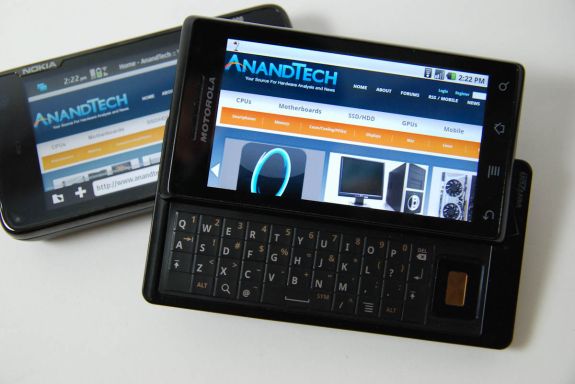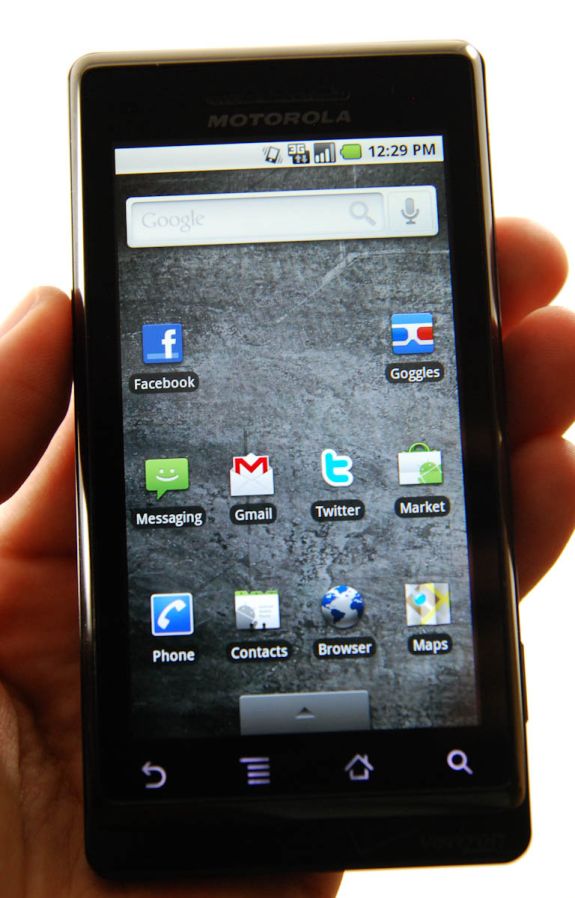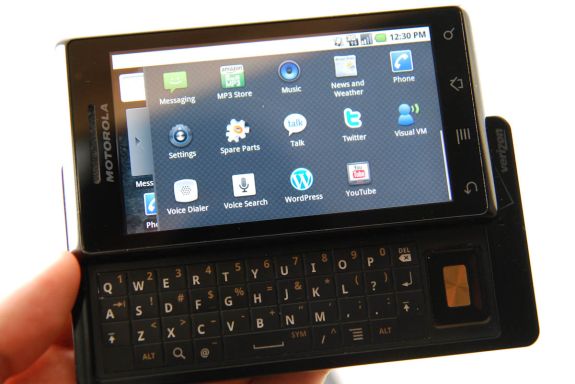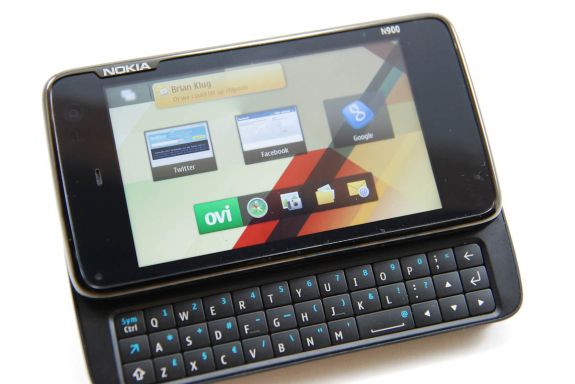Two OMAP 3430 Phones: Nokia N900 and Motorola Droid
by Brian Klug on June 10, 2010 9:29 PM EST- Posted in
- Smartphones
- N900
- Maemo
- Motorola Droid
- Droid
- MeeGo
- Android
- Mobile
The Motorola Droid continues to be the king of Android devices that include a hardware keyboard, and the smartphone which bore the Android flagship crown for some time before the Nexus One. Meanwhile, the Nokia N900 runs Maemo linux 5 - the operating system which - with polish and joint collaboration with intel - will soon emerge as MeeGo and power a host of Moorestown-packing devices. We're doing something a bit irregular by reviewing both phones in one article, but that's again because they're both running on the same Texas Instruments OMAP3 SoC. Let’s dive into both phones and see how they fare.
Motorola Droid - Still Does
As you probably already know, the Motorola Droid marked a turning point for Motorola, for Verizon’s smartphone lineup, and quite possibly a coming of age for Android as the first shipping smartphone with a mature 2.0 release. It wowed the market when it debuted Google Navigation, but puzzled everyone with its initial lack of multitouch support inside all official Google apps - despite packing a full multitouch digitizer.
Since launch, the Moto Droid has and will continue to see continual incremental updates. First, the Android 2.1 update added multitouch to the browser, gallery, and google maps, along with a number of other improvements brought alongside the entire platform update. At Google I/O 2010, we’ve now learned that the Moto Droid will see another update to Android 2.2 before year’s end - bringing a promised 2-5x speed boost to Android’s Dalvik virtual machine with a new JIT compiler, full in-browser Flash 10.1 in addition to Adobe Air support, cloud-to-device push APIs, OS-level WiFi tethering, and browser speed increases among other features.
It’s obvious that despite the recent release of the HTC Incredible, the Moto Droid will continue to hold a place in Verizon’s growing lineup of Android smartphones - and likely at a lower price point than HTC’s new flagship. Currently, Verizon is offering a buy one get one free Motorola Droid promption with purchase and a 2-year contract.
The Droid’s chief differentiating factor (other than likely continued lower price point) is the hardware keyboard. For so many, having a hardware keyboard is still a fundamentally important feature, though virtual keyboards aren’t as bad as they used to be - and they’re getting better. As an aside, it’s amazing how quickly ‘Big Red’ Verizon turned its lineup around and became host to so much Android hardware.
Nokia N900 - a ‘mobile computer’
There’s no doubt about it - the Nokia N900 is a unique beast. In fact, it’s that uniqueness which makes it a difficult sell for all but the most hardcore smartphone consumers, but also potentially the most powerful. The N900 is a landscape QWERTY slider with a 3.5” resistive LCD, front and back facing cameras, 3G HSPA for T-Mobile bands, and runs the debian derivative Maemo 5 OS.
I think it’s a fair argument to make that the N900 hasn’t received as much love state-side as it has abroad, or rightfully deserves. That’s probably due in part to only being sold unlocked with no subsidy, by no specific carrier (though it is targeted at T-Mobile for 3G support, and will work with 2.5G EDGE on AT&T), for $499 at retailers like Amazon. But it isn’t just Nokia grappling with that issue - Google recently learned how hard of a sell unsubsidized, bring your own plan schemes are with its Nexus One. In general, it’s hard to sell people on a $500+ smartphone if they can’t try the device beforehand, or get carrier support.
That aside, the N900 is likely the final evolution in a long chain of internet tablets designed by Nokia - starting with the N770 in 2005. Maemo linux has been as open as open source can be since the very beginning; its application manager started as little more than an APT frontend. If you prefer, it can even still be used that way from the XTerm terminal with an apt-get install. It’s a platform that’s been adorned and worshiped as the ultimate linux smartphone platform by hardcore *nix nerds ever since, and I intend to do it justice.














68 Comments
View All Comments
Fri13 - Sunday, June 20, 2010 - link
Symbian is server-client architectured operating system. Symbian has EKA2 microkernel + servers (modules). But Symbian is not at same time _just_ the operating system. It has other features (like libraries and so on) as well what does not belong to the actual OS.Fact is that Symbian really is open source.
But in other hand, the Android is not the operating system. It is a software system. The Linux is the operating system in the Android. Linux is monolithic kernel. Monolithic kernel is exactly same thing as operating system. It is the oldest (actually original) OS architecture. Server-client and layered architectures were developed almost few decades after the monolithic because there was demand to get OS architecture what is in theory more secure and more stable, but slower.
Symbian is licensed under EPL. While Linux OS is licensed under GPLv2 (only).
Both licenses are aproofed by the OSI and FSF. So both OS's are Libre software.
Android is software system what has multple different licensed software in it. The Linux OS in it is the GPLv2 (what can not be changed) and the distributor itself can use as well closed source software if the license allows. Usually this means that the software platforms or the softwares what are responsible for user interface can be with different license than F/OSS license.
By the facts, it is not true at all to say that "Android is not F/OSS operating system". Because a) Linux kernel is the operating system in Android. Android is just one distribution of the Linux. b) When talking about the operating systems and android, if wanted to be very wide speaking by terms, then Android is totally F/OSS.
numberoneoppa - Thursday, June 10, 2010 - link
Great article, Brian. I learned a lot. =)legoman666 - Thursday, June 10, 2010 - link
I love my N900 :D I bought it last November, right when it was first released. I had a N810 at the time, so I was excited to get the next iteration. With PR1.2 and a modest overclock to 800mhz, it scores ~12000ms on the sunspider javascript benchmark, which is on par with the HTC Incredible and the Nexus 1.I didn't have to get t-mobile, as my local carrier, Cincinnati Bell, uses the same 3g frequencies as T-mobile. I get blazing fast speeds of 3mb/s.
As Brian said in the review, the Skype integration is excellent. It even tells you how much credit you have remaining and the call cost at the end of the call. (And I can make video calls over 3g, take that iPhone)
topsecret - Thursday, June 10, 2010 - link
You should test the N900 with it running meego.Talcite - Friday, June 11, 2010 - link
Nokia doesn't plan to port meego to the N900.CityBlue - Friday, June 11, 2010 - link
Yes they do plan to port MeeGo to the N900 - in fact, the N900 is the primary development platform for MeeGo so not making it available in one form or another would be utterly ridiculous.What Nokia have said is that the version of MeeGo that will be made available for the N900 will not be officially supported, which basically means you can't go running to Nokia Care when you find a bug. Since I can't believe anyone does this even with a supported OS, the lack of Nokia Care is no great loss - you'll still have a very large and committed community to fall back on for help.
So in brief: Yes, MeeGo *IS* coming to the N900 - whether you install it or not is your choice.
jed22281 - Friday, June 11, 2010 - link
Yup, exactly what cityblue said.Brian needs to clarify this in his article.
There'll be plenty of "unofficial" support for meego on n900
tbutler - Wednesday, June 23, 2010 - link
...sorry, those airquotes have some very painful memories for those of us who lived through the 770 era. When 'unofficial' support meant a kludged-together hack.Brian Klug - Friday, June 11, 2010 - link
Thanks for the clarification CityBlue, I'll definitely update. I wrote some of this partially when support wasn't fully understood.-Brian
topsecret - Friday, June 11, 2010 - link
"the Motorola Droid remains the flagship of Android phones that come with a hardware keyboard"I dunno, the samsung moment is a pretty nice phone.